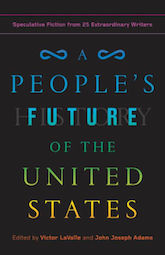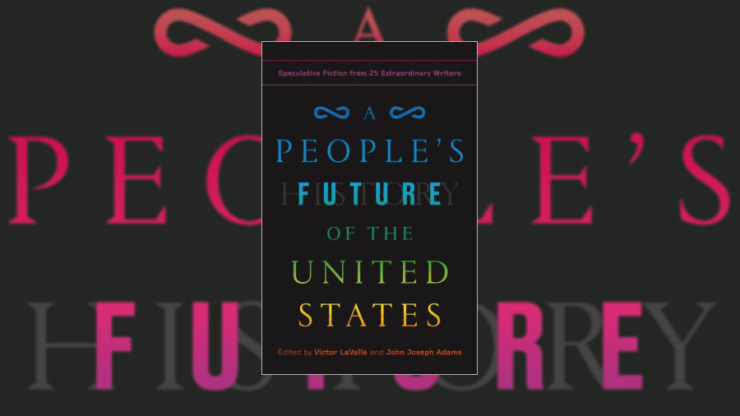There are a couple of ways to judge an anthology.
The simplest way to appraise one is to reduce the book down to its constituent parts. An anthology is, after all, a collection of stories. And A People’s Future of the United States—edited by Victor LaValle and John Joseph Adams—is, indeed, a collection of stories. 25 original stories, from a veritable Who’s Who of contemporary American speculative writers.
And, as a collection of stories, A People’s Future does, indeed, collect some very good stories. Reviewed through this entirely arbitrary lens, A People’s Future is, in fact, a stonking success. N.K. Jemisin’s glorious “Give Me Cornbread, or Give Me Death”, Malka Older’s inventive “Disruption and Continuity” and Omar El Akkad’s heart-breaking “Riverbed” are all utterly exceptional works. These three alone are worth the price of a copy. If that’s all an anthology is—a collection of stories—well then, A People’s Future has some great ones. (There are also numerous good ones, some ok ones, and a few that I didn’t like at all. That’s anthologies.) Success. Done.
But that’s a pedestrian interpretation of what an anthology is—or, should be.
An anthology is a shared vision. An editorial dream, dragged into reality by a dozen, two dozen, wild horses. Many journeys from one starting point, hopefully all running in (loosely) the same way. Breaking an anthology like A People’s Future down into its component parts not only diminishes it, but misses out on the very purpose of its existence. This is not twenty-five individual and discrete voices; this is a holistic shout. And, let’s be clear, A People’s Future is undeniably a shout. It is not a debate or a discussion: it is a full-throated, blood-curdling scream.
Judged by that criteria, whether or not it has a consistent and compelling vision, A People’s Future is, again, undeniably successful. In his introduction, Victor LaValle describes how he wanted to assemble ‘writing that gives us new futures to believe in’, and the anthology provides just that. From start to finish, this is a full range of futures that we, the reader, can find believable. Sure, these stories include the occasional dragon, or time travel, or enormous battle robot, but the beautiful tragedy of A People’s Future is that it is entirely plausible… and fundamentally terrifying.
That last twist is, I believe, the most important—and perhaps controversial—aspect of A People’s Future. These are not hopeful stories. These are stories of oppression and repression; social, political and environmental destruction on an apocalyptic scale. These are some of America’s most imaginative minds, all focused on describing the slippery slope of modern society. The results are, almost entirely, gruelling.
The nuances vary in the individual stories: revenge, retribution, anger, torment, rebellion. But the stories are united by their outrage. This (waves hands to indicate the entirety of contemporary America) is not alright.
There are a few stories that dare to conclude in a blanket, triumphal resolution—a sort of ‘look, we’ve fixed the timeline and/or started the revolution and/or all solved our differences with a shared love of fantasy fiction!’. But these are so wistfully cheerful that they merely to serve to emphasise the grinding brutality of the other entries. It was also telling that the most sweepingly hopeful stories often relied on external factors: magic, time travel, or hand-wavey science. Believing that magic will save us is, in some ways, more damning than having no hope at all.
Buy the Book


A People’s Future of the United States
The stories in A People’s Future are more small scale—generally personal struggle against a backdrop of dystopian world-building. Optimistically read, this is a collection of individual triumphs: ‘characters [that] don’t flee, they fight’. Potential futures in which we’re not dead (yet), and that people like us—all of us—are still there, persisting. But, that is the limit of the hope that the anthology provides. Again, A People’s Future informs us, in detail, that this is not alright. And, based on these stories, it is going to get a lot worse before it gets better. If ever. What the book does promise is that the “future belongs to [you] as much as anyone”. But, between the lines, it also promises that you’ll have to go out there and take it. If you want a happy ending, you will need to write it yourself.
A People’s Future is a powerful anthology. This is not a book that will unify the country, nor bridge any of its many divides. In some stories, it is undeniably preachy; in others, it indulges the insular superiority of science fiction readers. But in others—noted above—there are soaring heights of imagination, spirit and humanity.
As a vision—as a scream—A People’s Future is potent and resonant, with the potential to echo for years to come. For those it is speaking to, A People’s Future offers not hope, but belonging. A shared sense of outrage. A unifying call to arms. And, above all, the reassurance that now, then, and forever, you are not alone. As LaValle says: “The future is ours. Let’s get it.”
A People’s Future of the United States is available from One World.
Jared Shurin is the editor of The Djinn Falls in Love, The Outcast Hours, The Best of British Fantasy, and many other published and/or forthcoming works. He writes irregularly at raptorvelocity.com and continuously at @straycarnivore.











This seems to be a shared world anthology.
Fortunately, not the world we actually live in which, as Steven Pinker has so brilliantly shown, gives us many reasons to be hopeful about the future.
One problem with this review is that it’s obvious that the anthology is coming from a particular point of view, but that point of view is never stated. I’m assuming from the title that it’s coming from the hard Left, but titles have lied before. I’m going to assume that my assumption is correct and not buy the book. But I might be missing out because the review left the issue up in the air and I had to assume.
Why am I skipping it? Because there’s a whole bunch of good books out there, so I have to filter the pile somehow.
#2 FCoulter, what modern SFF authors do you consider “right-leaning”? (I define “right-leaning” as favoring the general political and economic policy wishes of the current Republican party.) I can’t think of any off-hand, beyond some of the the sword-and-sorcery and military subgenres authors. I would classify most commonly anthologized writers as “left-leaning”, “neutral”, or “implied politics not relevant”.
@2 — You can find out more here:
https://www.penguinrandomhouse.com/books/561572/a-peoples-future-of-the-united-states-by-edited-by-victor-lavalle-and-john-joseph-adams/9780525508809/
It’s presented as literary and speculative fiction; the dread word science does not appear.
Amusingly, the publisher tries to make the book sound more optimistic than (judging from the posting above) it actually is.
@3 – There is far more to political thought than the simplistic Left / Right spectrum. The fact that you think the only alternative to the Far Left is being a Trump supporter concerns me. For example, there’s a very strong libertarian strand in Science Fiction. If this is new to you, I suggest you look at the nominees and winners of the Prometheus Awards. You’ll probably recognize some of the names.
Here’s a link to the winners – http://lfs.org/awards.shtml ; I’m sure that you can find the various nominees; the LFS doesn’t make it easy to find them. (Perhaps by browsing the blog or press releases?)
@@.-@ – According to the Press Release, the book is
The problem is that oppression comes from all sides of the political divide, not just from the Right. But if the book is only dealing with oppression from the Right, it’s not one that I’m interested in reading. Too many blinders in the book’s conception.
It sure looks like that’s what the book’s basis is, but I could be wrong. Which is why I’m bringing it up.
@5
Sounds pretty libertarian to me.